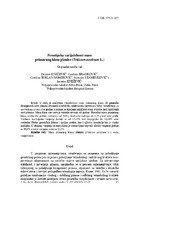Приказ основних података о документу
Phenotypic variability of weight of wheat (Triticum aestivum L.) primary spike
Fenotipska varijabilnost mase primarnog klasa pšenice (Triticum aestivum L.)
| dc.creator | Knežević, Desimir | |
| dc.creator | Branković, Gordana | |
| dc.creator | Šurlan-Momirović, Gordana | |
| dc.creator | Stamenković, Svetislav | |
| dc.creator | Knežević, Jasmina | |
| dc.date.accessioned | 2020-12-17T19:54:37Z | |
| dc.date.available | 2020-12-17T19:54:37Z | |
| dc.date.issued | 2010 | |
| dc.identifier.issn | 0354-5695 | |
| dc.identifier.uri | http://aspace.agrif.bg.ac.rs/handle/123456789/2381 | |
| dc.description.abstract | The development of new cultivars with high yield, better quality and high adaptability to different environmental conditions is a permanent task in wheat breeding programmes. Genetic variability of parent for hybridization is a main focus in the improvement of the developed cultivars. In order to improve different traits it is necessary to conduct a special selection of parents after the analysis of expression of certain traits. The primary spike weight was analysed in 20 genetic divergent wheat cultivars originating from various breeding centres of Serbia. Cultivars were grown in two years which were characterised with different climatic conditions. The average weight of primary spikes for both years of growing varied from 3.00 g in the cultivar Zadruga to 4.23 g in the cultivar Gruža. The value of the coefficient of variation ranged from 12.42% in Tanjugovka to 18.46% Orašanka cultivars. The effect of genetic and environmental factors and their interaction was highly significant. The largest impact of the year, i.e. the cultivar with 38.6%, i.e. 32.2% of variance, respectively was established for the expression of the spike weight in analysed wheat cultivars. Prospective cultivars, such as Gruža, Kremna, KG-75 and Tanjugovka, to be used in the breeding process are those that have expressed stable spike weights under different climatic conditions with high average values. . | en |
| dc.description.abstract | U radu je izučavana varijabilnost mase primarnog klasa 20 genetički divergentnih sorti pšenice stvorenih u različitim selekcionim centrima u Srbiji. Istraživanja su sprovedena u toku dve godine u kojima je ispoljena različitost ovog svojstva kod ispitivanih sorti pšenice. Masa klasa iste sorte je varirala zavisno od godine. Prosečna masa primarnog klasa, u toku dve godine, varirala je od 3,00 g kod sorte zadruga, do 4,23 g kod sorte gruža. Vrednost koeficijenta varijacije kretala se od 12,42% kod tanjugovke do 18,46% sorte orašanka. Efekat genetičkih faktora i spoljne sredine, kao i njihove interakcije bio je visoko značajan. U ukupnoj varijansi za masu klasa,je ustanovljeno najveće učešće varijanse godine sa 38,6% a zatim varijanse sorte sa 32,2%. . | sr |
| dc.publisher | Savez poljoprivrednih inženjera i tehničara, Beograd | |
| dc.rights | openAccess | |
| dc.source | Journal of Scientific Agricultural Research | |
| dc.subject | masa primarnog klasa | sr |
| dc.subject | pšenica (Triticum aestivum L.) | sr |
| dc.subject | sorta | sr |
| dc.subject | varijabilnost | sr |
| dc.title | Phenotypic variability of weight of wheat (Triticum aestivum L.) primary spike | en |
| dc.title | Fenotipska varijabilnost mase primarnog klasa pšenice (Triticum aestivum L.) | sr |
| dc.type | article | |
| dc.rights.license | ARR | |
| dc.citation.epage | 21 | |
| dc.citation.issue | 3 | |
| dc.citation.other | 71(3): 15-21 | |
| dc.citation.rank | M52 | |
| dc.citation.spage | 15 | |
| dc.citation.volume | 71 | |
| dc.identifier.fulltext | http://aspace.agrif.bg.ac.rs/bitstream/id/1176/2378.pdf | |
| dc.identifier.rcub | https://hdl.handle.net/21.15107/rcub_agrospace_2381 | |
| dc.type.version | publishedVersion |


